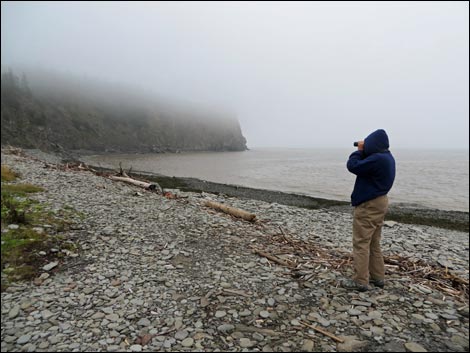
Home | Postcards | Mega Road Trip

Day 50. July 10, 2014. Thursday. Fundy National Park, New Brunswick
Today we didn't do much, but we sure had a good time taking all day to do it.
We awoke to the sound of the alarm (we use it because it gets light far too early to get up), cloudy skies, and the sound of rain on the roof of the van. Thinking we had another rainy day, we slept in an hour before realizing that it wasn't actually raining; what we were hearing was drops of water dripping from the fog-swept trees. In essence, the trees were catching moisture from the fog and dripping it on the ground.
While cleaning up after breakfast, we realized that our neighbor was a birder, and talking with Emily from Prince Edward Island took an hour, but it was worth the time. Perhaps she will visit us in Las Vegas when she comes for a vet conference. The pesky squirrel was still around and managed to get into the food in the van when we weren't looking. The little criminal stole our food.
Finally, we started out towards Mary's Point, the famous birding spot back up the coast. Emily had suggested that we look for Nelson's Sparrows in a salt marsh along the way. The directions weren't very specific: just some beach near a town... Well, we almost skipped it because the fog was so dense we couldn't see 100 yards, but we stopped at some unlikely spot, got out of the van, and Liz says: there is a bird song out there that I've never heard. Sure enough, we found and photographed the elusive Nelson's Sparrow (LB#636).
From there, we drove farther north to Cape Enrage, and sure enough, we drove all the way out there and couldn't see 30 yards into the dense fog. Reported to be the best view in all of New Brunswick, and we couldn't see it. We were enraged! Driving back, we stopped at another beach just to look at the water. In the marsh behind the beach we might have heard more Nelson's Sparrows, but we weren't sure. We did, however, see Common Eider in the cove, a salamander under a rock, and a bunch of plant fossils (well, plant-part fossils, but it was still cool to find them unexpectedly on our own).
We drove farther north and finally got to Cape Mary's (part of a National Wildlife Refuge) as the fog was thinking about lifting. In the contact station, we spent another delightful hour in conversation with three young ladies from the biology department of the college up here who had been hired as seasonal biologists. They weren't bird experts, but they were energetic and eager to learn, and they will be having fun counting birds and interacting with the public. By the time we went outside to walk down to the beach, the sun had come out and it was bright and sunny. Liz and I had a fun walk with lots of birds in the trees (Purple Finch, Common Yellowthroat), but as we expected, the hoards of shorebirds had not yet arrived. Even so, a walk on a sandy beach on the shore of the Bay of Fundy watching the tide race out was a treat, a windy treat, but a treat nonetheless.
We started heading back to Cape Enrage now that the fog had lifted, but we were distracted by a pullout at a marsh with a Bald Eagle and a bunch of Turkey Vultures. We ate our lunch watching and wondering what they were eating for their lunch. Black Ducks, Red-winged Blackbirds, and Sora were also eating lunch, and Nelson's Sparrows were singing in the marsh.
Finally heading back towards Cape Enrage, we were again enraged as the fog piled back in. This time, we skipped the access road and headed back towards Fundy National Park. We picked up groceries and headed back towards the campground, but were waylaid by a scenic overlook for one last look at the Bay of Fundy. We could see the water, we could see the far shore, and we could see a huge pile of fog blanketing Cape Enrage. We were glad we skipped it the second time.
Back in Chignecto Campground, we got a different site to avoid our furry criminal friend. After dinner (Liz fixed pork chops!), we walked around camp listening to the birds and saw Red-eyed Vireo, Black-throated Green Warbler, Yellow-rumped Warbler, Magnolia Warbler, plus we heard Hermit Thrush and Swainson's Thrush singing. Back in camp for the night, we had another Swainson's Thrush singing just above our heads.
 Finding Nelson's Sparrow |
 Cape Enrage up there in the dense fog |
 Saint Mary Beach |
 Pork chops for dinner |
Note: All distances, elevations, and other facts are approximate.
![]() ; Last updated 140711
; Last updated 140711
| Mega Road Trip | Copyright, Conditions, Disclaimer | Home |